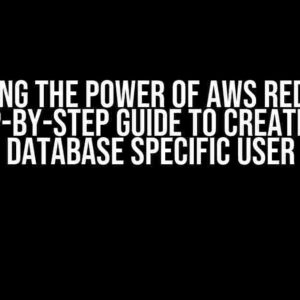Are you tired of dealing with pesky scheduled jobs in Solid Queue that are no longer needed or are causing more harm than good? Do you want to know the secret to destroying them once and for all? Look no further! In this comprehensive guide, we’ll take you through the process of destroying scheduled jobs from Solid Queue with ease.
What are Scheduled Jobs in Solid Queue?
Solid Queue is a powerful tool used to manage and process background jobs in your application. Scheduled jobs are a type of job that runs at a specific time or interval, allowing you to automate tasks and workflows. While scheduled jobs can be incredibly useful, there may come a time when you need to destroy them.
Why Destroy Scheduled Jobs?
There are several reasons why you might need to destroy scheduled jobs in Solid Queue:
- The job is no longer needed or has become obsolete.
- The job is causing performance issues or errors.
- The job is conflicting with other jobs or processes.
- You want to clean up unnecessary jobs to improve system efficiency.
Preparing to Destroy Scheduled Jobs
Before you start destroying scheduled jobs, it’s essential to prepare your environment and ensure you have the necessary tools and permissions. Here’s what you need to do:
- Make sure you have access to the Solid Queue dashboard with admin privileges.
- Familiarize yourself with the Solid Queue UI and navigation.
- Backup your Solid Queue data to prevent any accidental losses.
- Identify the scheduled jobs you want to destroy and make a note of their IDs or names.
Destroying Scheduled Jobs using the Solid Queue UI
The easiest way to destroy scheduled jobs is using the Solid Queue UI. Here’s how:
- Log in to your Solid Queue dashboard and navigate to the “Jobs” tab.
- Click on the “Scheduled” tab to view a list of all scheduled jobs.
- Find the job you want to destroy and click on the three vertical dots at the end of the row.
- Click on “Destroy” from the dropdown menu.
- Confirm that you want to destroy the job by clicking “Destroy” again in the popup dialog.
Repeat this process for each scheduled job you want to destroy.
Destroying Scheduled Jobs using the Solid Queue API
Alternatively, you can destroy scheduled jobs using the Solid Queue API. This method is more advanced and requires programming knowledge.
import requests
# Set your Solid Queue API endpoint and token
endpoint = "https://your-solid-queue-instance.com/api"
token = "your-api-token"
# Set the job ID or name
job_id = "your-job-id"
# Make a DELETE request to destroy the job
response = requests.delete(f"{endpoint}/jobs/{job_id}", headers={
"Authorization": f"Bearer {token}"
})
if response.status_code == 204:
print(f"Job {job_id} destroyed successfully!")
else:
print(f"Error destroying job {job_id}: {response.text}")
Make sure to replace the placeholders with your actual Solid Queue API endpoint and token, as well as the ID or name of the job you want to destroy.
Best Practices for Destroying Scheduled Jobs
To avoid any issues when destroying scheduled jobs, follow these best practices:
- Double-check the job ID or name before destroying to ensure you’re targeting the correct job.
- Verify that the job is not currently running or processing before destroying it.
- Destroy jobs in batches instead of individually to improve performance.
- Monitor Solid Queue logs and metrics after destroying jobs to ensure everything is working as expected.
Troubleshooting Common Issues
If you encounter any issues while destroying scheduled jobs, refer to the following troubleshooting tips:
| Issue | Solution |
|---|---|
| Error 404: Job not found | Verify the job ID or name is correct and the job exists in Solid Queue. |
| Error 403: Permission denied | Check that you have admin privileges and the necessary permissions to destroy jobs. |
| Error 500: Internal Server Error | Check the Solid Queue logs for errors and contact support if the issue persists. |
Conclusion
Destroying scheduled jobs in Solid Queue is a straightforward process that can be done using the UI or API. By following the steps outlined in this guide, you’ll be able to efficiently destroy unwanted scheduled jobs and maintain a clean and organized Solid Queue environment.
Remember to always exercise caution when destroying jobs and follow best practices to avoid any issues. If you encounter any problems or have questions, don’t hesitate to reach out to Solid Queue support.
Final Checklist
Before you go, make sure to:
- Backup your Solid Queue data.
- Identify and destroy all unwanted scheduled jobs.
- Monitor Solid Queue logs and metrics after destroying jobs.
- Test your application to ensure everything is working as expected.
By following this comprehensive guide, you’ll be able to confidently destroy scheduled jobs in Solid Queue and keep your background job processing running smoothly.
Frequently Asked Questions
Got questions about destroying scheduled jobs from Solid Queue? We’ve got answers!
How do I destroy a scheduled job in Solid Queue?
To destroy a scheduled job, simply use the `destroy` method provided by Solid Queue. For example, if you have a job instance called `job`, you can call `job.destroy()` to remove it from the queue. This will prevent the job from being executed in the future.
What happens if I destroy a scheduled job that’s already running?
If you destroy a scheduled job that’s already running, Solid Queue will attempt to gracefully terminate the job. However, this may not always be possible, and the job may continue to run until it completes. It’s generally a good idea to ensure that any running jobs are completed or cancelled before destroying them.
Can I destroy multiple scheduled jobs at once?
Yes, Solid Queue provides a `destroy` method on the `Queue` instance that allows you to destroy multiple jobs at once. You can pass an array of job IDs or instances to this method, and Solid Queue will remove them from the queue.
What if I want to destroy all scheduled jobs in a queue?
Easy one! Solid Queue provides a `flush` method on the `Queue` instance that will remove all scheduled jobs from the queue. This can be useful if you want to clear out a queue completely.
Are destroyed jobs removed from the database?
Yes, when you destroy a scheduled job in Solid Queue, it will be removed from the database. This means that the job will no longer be stored in the database and will not be retrieved or executed in the future.



